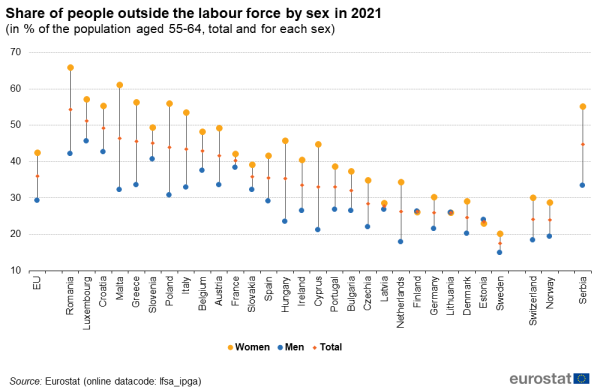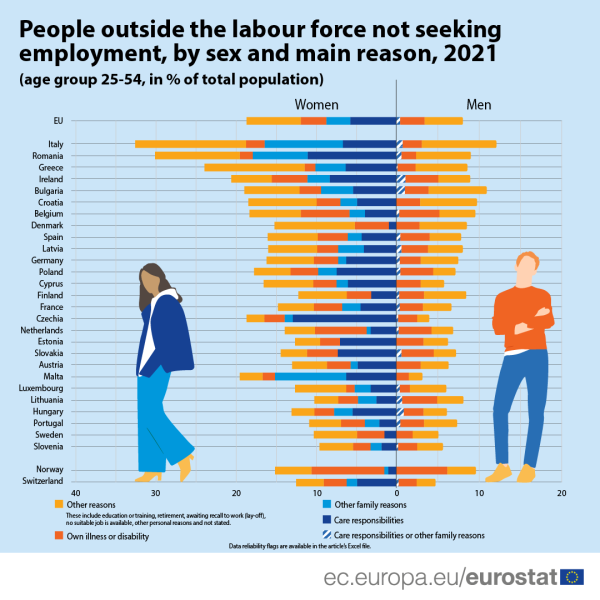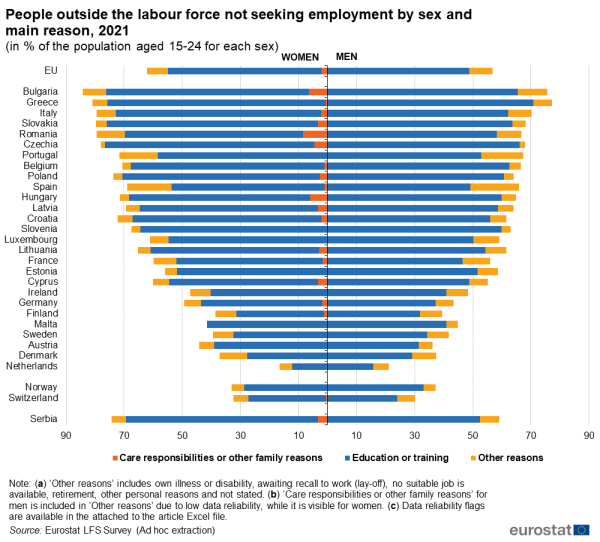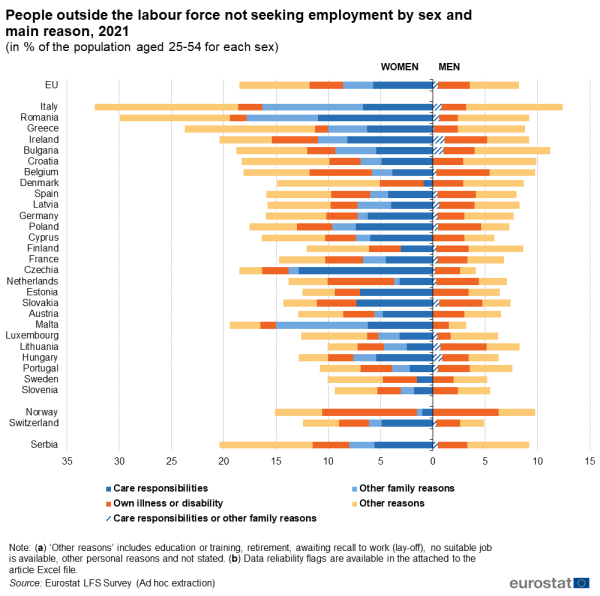Archive:People outside the labour force
This Statistics Explained article has been archived - for recent articles on labour market see here.
Data extracted in June 2022
Planned article update: July 2023
Highlights
The group of people outside the labour force, i.e. people neither employed nor unemployed, is a varied group in sex, age, reasons for not looking for a job, and level of attachment to the labour force. Some of these individuals are discouraged from actively seeking employment and deserve particular attention in the context of the European Pillar of Social Rights Action Plan.
This article aims to characterise the group of people outside the labour force, mainly focusing on people aged 15-64. Specific analysis is done for the three age groups 15-24, 25-54 and 55-64, that correspond to different life situations as shown in this article. Results are presented for the age group 55-74 when data for 55-64 is not available. The age group 25-64, that merge the two age groups 25-54 and 55-64, is also looked at for the breakdown by educational attainment level.
This article is based on the Labour Force Survey (EU-LFS) and presents results for the EU as a whole, and also for all EU Member States individually, for two EFTA countries (Norway and Switzerland) and one candidate country (Serbia).
Full article
People outside the labour force: sex, age and level of education
This statistical article studies the people outside the labour force, i.e. people that are neither employed nor unemployed, and are defined by the fact that:
- they do not have a job, and
- they are either not actively searching for a job (a), or
- they are not immediately available to work (b), or
- both (a) and (b).
In 2021, around 1 in 4 people (26.4 %) aged 15-64 was outside the labour force, corresponding to 74.4 million people.
The proportion of people outside the labour force in the EU ranged from more than 30 % of the total population aged 15-64 in Italy (35.5 %), Romania (34.4 %), Greece (32.7 %), Croatia (31.3 %) and Belgium (30.3 %) to less than 20 % in Sweden (17.1 %) and the Netherlands (16.3 %) (see Figure 1).
In all countries, the share of women outside the labour force was higher than that of men. In Romania, Italy, Malta and Greece, the share of women outside the labour force exceeded the corresponding share of men by more than 15 percentage points (pp.) Romania, Italy and Greece also had the largest shares of women outside the labour force in the EU, with more than 40 % of women in all three countries outside the labour force.

Source: Eurostat (lfsa_ipga)
The percentage of people outside the labour force is significantly lower for people aged 25-54 than for those aged 15-24 and 55-74 (see Figure 2, EU level, data for 55-64 not available). This can be observed for all years between 2009 and 2021.
Looking at the long-term trend, the share of people outside the labour force aged 55-74 fell considerably from 2009 to 2021, dropping from 71.2 % to 60.5 % (a decrease of 10.7 pp.). During the same period, the change for the other age groups is much smaller: an increase in the share of people outside the labour force of 1.9 pp. for people aged 15-24 and a decrease of 2.4 pp. for those aged 25-54. As a result, the percentages of people outside the labour force aged 15-24 and aged 55-74 became very close (less than 1 pp. difference) in recent years (see the years 2020 and 2021).

Source: Eurostat (lfsi_sup_a)
Another factor that influences whether someone is outside the labour force is the level of education they have attained. People with a higher level of education are less likely to be outside the labour force, as shown in Figure 3 (over the age group analysed for education level, i.e. 25-64). There is a strong relationship between a person's level of education and the likelihood of them being outside the labour force irrespective of sex: the higher the education level, the smaller the share of people outside the labour force. Furthermore, the proportion of women outside the labour force was substantially higher than that of men in all three educational levels presented in Figure 3. However, the gender gap appears to decrease with increases in the level of education.
It is also worth noting that the shares of people outside the labour force aged 25-54 and 55-64 with a low level of education are very close. However, the distance between the shares of those two age groups widens at a medium and high level of education as the percentage of people outside the labour force gets significantly higher for age group 55-64 than for age group 25-54.

Source: Eurostat (lfsa_igaed) and (lfsa_pgaed)
The relationship between level of education and the share of people outside the labour force is also visible at country level (see Figure 4). In all countries except Sweden, more than a quarter of people aged 25-64 with a low level of education were outside the labour force, whereas in most countries fewer than 1 in 10 people with a high level of education were in the same situation.

Source: Eurostat (lfsa_igaed) and (lfsa_pgaed)
Young people are mainly in education
Young people aged 15-24 tend to be outside the labour force. In 2021, 60.7 % of all people aged 15-24 in the EU were outside the labour force (58.0 % of men and 63.6 % of women) (see Figure 5).
The lowest rate of young people outside the labour force among the EU countries was recorded in the Netherlands (20.9 %). Denmark (39.6 %) and Austria (43.7 %) followed the Netherlands by a large distance. In 19 EU countries, this share exceeded 50 % and reached more than 75 % in Italy (75.1 %), Greece (79.3 %) and Bulgaria (80.0 %). Differences between countries are largely explained by the number of young people combining studies and presence in the labour force (having or seeking a small side job). More information on the interplay between participation in education and in the labour market for young people can be found in the article 'Participation of young people in education and the labour market'.

Source: Eurostat (lfsa_ipga)
Most of the young people outside the labour force did not search for a job due to education or training. As a percentage of the total population aged 15-24 in the EU, these were 52.9 % of young women and 48.7 % of young men (see Figure 6). In most EU countries, this share was also higher for women than for men; among these countries the gap was the largest, exceeding 8 pp., in Croatia, Slovakia and Italy.
Another major sex-related difference concerning people aged 15-24 is that 2.1 % of the female population in the EU was outside the labour force and did not seek employment due to care responsibilities or other family reasons. This share reached its highest value among young women in Romania (8.5 %), followed by Bulgaria (6.4 %) and Hungary (6.0 %). Young men in the same situation were extremely rare, only 0.2 % at EU level.
Care responsibilities: main reason for women aged 25-54 to be outside the labour force
Regardless of sex, in 2021, Italy had the highest share of people outside the labour force aged 25-54, i.e. 22.7 %. In another 4 EU countries, this share was also above 15 %. These 4 countries were Romania, Greece, Ireland and Bulgaria (in descending order). By contrast, in Lithuania, Hungary, Portugal, Sweden and Slovenia, fewer than 1 in 10 people aged 25-54 were outside the labour force (see Figure 7).
In 2021, 8.8 % of men aged 25-54 were outside the labour force in the EU, compared with 19.4 % of women of the same age. The largest gender difference in the EU for this age group was found in Romania, where 30.0 % of women were outside the labour force, compared with 9.3 % of men. After Italy, Romania had the second-largest share of women outside the labour force in the EU, but the ninth largest share of men outside the labour force.

Source: Eurostat (lfsa_ipga)
There are significant differences in the reasons given by men and women outside the labour force aged 25-54 for not seeking employment. At EU level, the shares of women outside the labour force (in % of their total population) who did not look for a job due to care responsibilities (5.7 %) and other family reasons (2.9 %) were significantly higher than that of men. Even if those two categories of care responsibilities and family reasons are combined for men, the resulting share is only 0.5 % (see Figure 8).
At national level, the percentage of women outside the labour force aged 25-54 who did not seek employment due to care responsibilities exceeded 5 % in half of the EU countries, reaching 8.2 % in Ireland, 11.0 % in Romania and 12.8 % in Czechia. By contrast, the corresponding share for men, even if care responsibilities are combined with ‘other family reasons’, exceeded 1 % only in Ireland (1.1 %).
Retirement: main reason for people aged 55-64 to be outside the labour force
Looking at people aged 55-64, Romania (54.4 %), Luxembourg (51.2 %) and Croatia (49.3 %) recorded the highest share of people outside the labour force among the EU Member States in 2021 (see Figure 9). At the other end of the scale, in Denmark, Estonia and Sweden less than one-quarter of the population aged 55-64 was outside the labour force.
In 2021, 29.2 % of men and 42.5 % of women aged 55-64 were outside the labour force in the EU. At national level, significantly larger sex differences can be observed for this age group than for the younger generations (people aged 15-24 and 25-54). The largest gap between the shares of men and women outside the labour force aged 55-64 was in Malta (32.2 % for men versus 61.1 % for women) and Poland (30.7 % for men and 56.0 % for women). Furthermore, Malta, together with Romania (65.9 %) and Luxembourg (57.1 %), were the Member States with the highest share of women outside the labour force in the 55-64 age group.

Source: Eurostat (lfsa_ipga)
Retirement was the reason most frequently given by men aged 55-64 for being outside the labour force and not searching for employment, corresponding to 14.8 % of the total male population in the EU in this age group. The second most common reason was 'own illness or disability', with 8.7 % of all men aged 55-64 in the EU (see Figure 10).
Retirement was also the most frequently given reason for women in this age group: 16.9 % of them were outside the labour force and did not search for a job due to retirement. 'Own illness or disability' (8.7 %) and 'care responsibilities or other family reasons' (7.0 %) were the other most widespread reasons for being outside the labour force and not looking for a job among women aged 55-64 in the EU. In contrast to women, the share of men aged 55-64 being outside the labour force and not searching for a job due to care responsibilities or other family reasons was 0.7 %.
Willingness to work and search for employment
Some of the people outside the labour force are not interested in working. For instance, some people who are not searching for work do not even want to work (this is the case for many students). For others, the fact that they are not immediately available for work does not prevent them from seeking a job.
Figure 11 shows the distribution of people outside the labour force in the EU, categorised by whether or not they are willing to work and searching for employment. Large differences are visible, according to age group and sex.
The share of people who did not search for employment because they did not want to work was significantly higher among people outside the labour force aged 15-24 and 55-64 than among those aged 25-54. Conversely, people outside the labour force aged 25-54 had a larger proportion of people who did not search for employment but wanted to work and of people who searched for employment.
On differences by sex, the shares of men and women outside the labour force aged 15-24 and 55-64 were somewhat similar when broken down according to the search for employment and willingness to work. However, this was not the case for the people outside the labour force aged 25-54:
- the proportion of those aged 25-54 who did not search for employment but did not want to work was significantly higher among women (66 %) than among men (55 %) outside the labour force;
- the proportion of those aged 25-54 who did not search for employment but wanted to work was significantly higher among men (38 %) than among women (29 %) outside the labour force.
Source data for tables and graphs
Methods and definitions
Data sources
All figures in this article are based on the European labour force survey (EU-LFS).
Source: The European Union Labour Force Survey (EU-LFS) is the largest European household sample survey providing quarterly and annual results on labour participation of people aged 15 and over as well as on persons outside the labour force. It covers residents in private households. Conscripts in military or community service are not included in the results. The EU-LFS is based on the same target populations and uses the same definitions in all countries, which means that the results are comparable between the countries. The EU-LFS is an important source of information about the situation and trends in the national and EU labour markets. Each quarter around 1.8 million interviews are conducted throughout the participating countries to obtain statistical information for some 100 variables. Due to the diversity of information and the large sample size, the EU-LFS is also an important source for other European statistics like Education statistics or Regional statistics.
Please note that Eurostat provides two sets of indicators linked to the annual unemployment rate, which serve different purposes and which in some cases differ from each other:
1) The LFS main indicators, which contain seasonally adjusted series. They include the labour market headline indicators used e.g. in the Macroeconomic Imbalance Procedure Scoreboard or the European Statistical Recovery Dashboard and are consequently used for monitoring policy. They have only a few breakdowns and normally refer to the age group 20-64.
2) The detailed results, which contain series that are not seasonally adjusted. They have a large number of breakdowns and can therefore be used for more detailed analysis. For France, only one data series is published. This series contains data for metropolitan France until the fourth quarter of 2013, and from 2014 on, also the French overseas departments.
This article presents annual results for indicators from the "LFS main indicators" set.
Reference period: Yearly results are obtained as averages of the four quarters in the year.
Coverage: The results from the EU-LFS currently cover all European Union Member States, the EFTA Member States Iceland, Norway and Switzerland, as well as the candidate countries Montenegro, North Macedonia, Serbia and Turkey. For Cyprus, the survey covers only the areas of Cyprus controlled by the Government of the Republic of Cyprus.
European aggregates: EU and EU-27 refer to the sum of the 27 EU Member States. If data are unavailable for a country, the calculation of the corresponding aggregates takes into account the data for the same country for the most recent period available. Such cases are indicated.
Country notes
In Germany, from the first quarter of 2020 onwards, the Labour Force Survey (LFS) is part of a new system of integrated household surveys. Technical issues and the COVID-19 crisis has had a large impact on data collection processes in 2020, resulting in low response rates and a biased sample. For more information, see here.
In the Netherlands, the 2021 LFS data remains collected using a rolling reference week instead of a fixed reference week, i.e. interviewed persons are asked about the situation of the week before the interview rather than a pre-selected week.
Spain and France have assessed the attachment to the job and included in employment those who, in their reference week, had an unknown duration of absence but expected to return to the same job once health measures allow it.
Definitions
The concepts and definitions used in the survey follow the guidelines of the International Labour Organization (ILO):
- People outside the labour force are those who are neither employed nor unemployed.
- Employed people comprise:
(a) persons who during the reference week worked for at least one hour for pay or profit or family gain; (b) persons who were not at work during the reference week but had a job or business from which they were temporarily absent.
- Unemployed people comprise persons who were:
(1) not employed according to the definition of employment above; (2) currently available for work, i.e. were available for paid employment or self-employment before the end of the two weeks following the reference week; (3) actively seeking work, i.e. had taken specific steps in the four week period ending with the reference week to seek paid employment or self-employment or who found a job to start later, i.e. within a period of at most three months from the end of the reference week.
- Reason for being outside the labour force is the main reason why somebody is not searching for employment. Under this category are included both people who are interested, as well as people who are not interested in working. The main reason may or may not be the only reason. Only the main one is retained for analysis in this article.
- Level of education is defined according to the International standard classification of education, version 2011 (ISCED 2011). Eurostat’s online tables and databases present data on educational attainment for three aggregates (low, medium and high levels of education).
Time series
Regulation (EU) 2019/1700 came into force on 1 January 2021 and induced a break in the EU-LFS time series for several EU Member States. In order to monitor the evolution of employment, unemployment and people outside the labour force despite of the break in the time series, Member States assessed the impact of the break in their country and computed impact factors or break corrected data for a set of indicators. Break corrected data are published on the Eurostat website for the LFS main indicators.
Additional methodological information
More information on the EU-LFS can be found via the online publication EU Labour Force Survey, which includes eight articles on the technical and methodological aspects of the survey. The EU-LFS methodology in force from the 2021 data collection onwards is described in methodology from 2021 onwards. Detailed information on coding lists, explanatory notes and classifications used over time can be found under documentation.
Context
The European Pillar of Social Rights has been jointly signed by the European Parliament, the Council and the Commission on 17 November 2017. Employment and social policies are the main fields of interest of the European Pillar of Social Rights, which is about delivering new and more effective rights for citizens. It has 3 main categories: (1) Equal opportunities and access to the labour market, (2) Fair working conditions and (3) Social protection and inclusion. In particular, today's more flexible working arrangements provide new job opportunities especially for the young but can potentially give rise to new precariousness and inequalities. Building a fairer Europe and strengthening its social dimension is a key priority for the Commission. The European Pillar of Social Rights is accompanied by a ‘social scoreboard’ which will monitor the implementation of the Pillar by tracking trends and performances across EU countries in 12 areas and will feed into the European Semester of economic policy coordination. The scoreboard will also serve to assess progress towards a social ‘triple A’ for the EU as a whole.
Although labour market economists tend to focus on the activities and characteristics of people in the labour force, there has been continued, if less visible, interest in individuals outside of the labour force, especially those who want to work but are not currently seeking work. Much of this growing interest stems from concern over improving the availability of decent and productive employment opportunities in developing and developed economies alike.
Individuals are considered to be outside the labour force, if they are neither employed nor unemployed, that is, not actively seeking work. There is a variety of reasons why some individuals do not participate in the labour force; such persons may be occupied in caring for family members; they may be retired, sick or disabled or attending school; they may believe no jobs are available; or they may simply not want to work.
Direct access to
- All articles on employment
- Employment - annual statistics
- Unemployment statistics and beyond
- Youth unemployment
- Participation of young people in education and the labour market
- Labour market slack - employment supply and demand mismatch
- Labour market statistics at regional level
- Unemployment statistics at regional level
- Unemployment statistics
- Job vacancy statistics
- EU labour force survey
- Labour force survey in the EU, EFTA and candidate countries — Main characteristics of national surveys, 2020, 2022 edition
- Quality report of the European Union Labour Force Survey 2020, 2022 edition
- EU labour force survey — online publication
- European Union Labour force survey - selection of articles (Statistics Explained)
- LFS main indicators (t_lfsi)
- LFS series - Detailed annual survey results (t_lfsa)
- LFS main indicators (lfsi)
- LFS series - Detailed annual survey results (lfsa)
Publications
- EU labour force survey — online publication
- Labour force survey (LFS) – Main concepts
- Labour force survey in the EU, EFTA and candidate countries — Main characteristics of national surveys, 2020, 2022 edition
- Quality report of the European Union Labour Force Survey 2020, 2022 edition
- Statistical working papers / Manuals and guidelines
ESMS metadata files and EU-LFS methodology
- Employment and unemployment (Labour Force Survey) (ESMS metadata file — employ_esms)
- LFS main indicators (ESMS metadata file — lfsi_esms)
- LFS series - detailed annual survey results (ESMS metadata file — lfsa_esms)
- LFS series - detailed quarterly survey results (from 1998 onwards) (ESMS metadata file — lfsq_esms)
- LFS ad-hoc modules (ESMS metadata file — lfso_esms)




